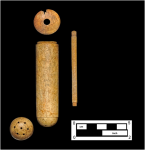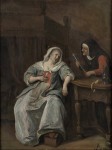 Archaeologists excavating the National Historic Landmark New York City Hall in lower Manhattan have unearthed a rare early 19th century vaginal syringe, a sort of proto-douche. Made from the bone of an unidentified mammal, the device was found in parts and the Chrysalis Archaeology team weren’t sure what its function was. Its three-inch hollow cylinder with rounded tip looks sort of like a pestle; a needle case was another possibility.
Archaeologists excavating the National Historic Landmark New York City Hall in lower Manhattan have unearthed a rare early 19th century vaginal syringe, a sort of proto-douche. Made from the bone of an unidentified mammal, the device was found in parts and the Chrysalis Archaeology team weren’t sure what its function was. Its three-inch hollow cylinder with rounded tip looks sort of like a pestle; a needle case was another possibility.
The discovery was made in 2010. The eureka moment wouldn’t happen for another three years. It wasn’t until archaeologist Lisa Geiger saw a group of late 19th century glass vaginal syringes at Philadelphia’s Mütter Museum (is there anything the Mütter’s collection can’t do?) that she realized what the City Hall tool was and began researching the history of these devices.
 The syringe was found in a buried garbage pile that dates to between 1803 and 1815. The garbage begins three feet under street level and goes down another three feet. It’s filled with liquor bottles and food waste and may be the impressive remains of a single epic party. Construction on City Hall began in 1810 and ended in 1812, so right around the time this infamous liquor and douche party may have taken place. Before that, the area was the city commons, known as “The Fields,” site of public pasture land, the old Debtor’s Prison, run as a POW jail by the brutal British Provost Marshall William Cunningham during the Revolutionary War, the Bridewell prison and the poorhouse.
The syringe was found in a buried garbage pile that dates to between 1803 and 1815. The garbage begins three feet under street level and goes down another three feet. It’s filled with liquor bottles and food waste and may be the impressive remains of a single epic party. Construction on City Hall began in 1810 and ended in 1812, so right around the time this infamous liquor and douche party may have taken place. Before that, the area was the city commons, known as “The Fields,” site of public pasture land, the old Debtor’s Prison, run as a POW jail by the brutal British Provost Marshall William Cunningham during the Revolutionary War, the Bridewell prison and the poorhouse.
Vaginal syringes were used by women for contraceptive purposes to flush out sperm after intercourse and to treat gynecological ailments from venereal diseases to menstrual cramps to “the Whites,” aka vaginal discharge. Although they became increasingly popular in the 19th century, syringes were in active use in modern Europe as early as the 17th century. The civic museum in Zwolle, the Netherlands, has two rare 17th century wooden ones that are rather more artistically designed (read: penis-shaped, one complete with decorative scrotum) that were also found in historical garbage, namely in the cesspit of a private home.
 They make an appearance in 17th century Dutch art as well. Jan Steen was overtly fond of painting domestic scenes of swooning women being treated by questionable doctors for “lovesickness.” He made multiple versions of these tableaux, all of them with details like cupid statues, boys holding arrows or herrings meant to convey phalluses, background paintings of mythological sexytimes and unmade beds suggesting that taking the pulse of the lady wasn’t going to cure what ailed her. Two of them, The Sick Woman (1660-70) and The Doctor’s Visit (ca 1665), both now in the permanent collection of the Museum Boijmans Van Beuningen in Rotterdam, feature figures holding vaginal syringes. A particularly formidable example is wielded by an old lady, a midwife perhaps, in the first painting, while a little boy holds a slightly less endowed version in the second. Both characters are snickering, because, as the paper on the floor of The Doctor’s Visit notes, “No medicine is of use, for it is lovesickness.”
They make an appearance in 17th century Dutch art as well. Jan Steen was overtly fond of painting domestic scenes of swooning women being treated by questionable doctors for “lovesickness.” He made multiple versions of these tableaux, all of them with details like cupid statues, boys holding arrows or herrings meant to convey phalluses, background paintings of mythological sexytimes and unmade beds suggesting that taking the pulse of the lady wasn’t going to cure what ailed her. Two of them, The Sick Woman (1660-70) and The Doctor’s Visit (ca 1665), both now in the permanent collection of the Museum Boijmans Van Beuningen in Rotterdam, feature figures holding vaginal syringes. A particularly formidable example is wielded by an old lady, a midwife perhaps, in the first painting, while a little boy holds a slightly less endowed version in the second. Both characters are snickering, because, as the paper on the floor of The Doctor’s Visit notes, “No medicine is of use, for it is lovesickness.”
 Medicine was certainly deemed of use by doctors, apothecaries and herbalists. English botanist Nicholas Culpeper wrote in his 1653 compendium Complete Herbal about the appropriate herbal remedies for various women’s troubles to be applied directly into the afflicted region: Lady’s Mantle, Amaranth, Plantain and Feverfew, among others.
Medicine was certainly deemed of use by doctors, apothecaries and herbalists. English botanist Nicholas Culpeper wrote in his 1653 compendium Complete Herbal about the appropriate herbal remedies for various women’s troubles to be applied directly into the afflicted region: Lady’s Mantle, Amaranth, Plantain and Feverfew, among others.
Monsieur Pierre Pomet, owner of an apothecary shop and chief druggist to King Louis XIV, wrote extensively about what kind of nostrums women should inject into their vaginas via syringe, and he didn’t stick to herbs. From the 1748 translation of A Complete History of Drugs by Pierre Pomet, first published in French in 1684 and translated into English in 1712:
The Aqua Styptica Composita, or the Compound Styptick Water, is made of this [white] Vitriol, and other Ingredients in the following Manner. Take purified white Vitriol, Roch Alum, of each an Ounce; Saccharum Saturni, half an Ounce; Spring Water, two Quarts, mix and dissolve over a gentle Heat, digest close stopt ten Days; decant the clear, filtrate, and keep it for Use. This is an easy Preparation, and of few and simple Ingredients, but of no mean Use. It is a good Injection (Universals being first premised) against the Whites in Women, and the Gonorrhea in Men, though of never so long standing, and possibly may do more in two, three, or four Days Time, being injected, than all other Medicines could do in as many Years.
 By the late 19th century, home medical care assumed the easy availability of vaginal syringes. Here is a treatment for leucorrhoea (the so-called “Whites”) from Gunn’s Newest Family Physician by John C. Gunn, published in 1883:
By the late 19th century, home medical care assumed the easy availability of vaginal syringes. Here is a treatment for leucorrhoea (the so-called “Whites”) from Gunn’s Newest Family Physician by John C. Gunn, published in 1883:
The first is cleanliness, by bathing freely with cold or tepid water, and injecting it up the birthplace three or four times a day with a female syringe, which can be purchased at any drug store. The glass syringe is preferable. […]
I have used an injection of Green Tea with much benefit, which may be substituted for the simple water, either cold or tepid, which ever appears to be most beneficial. Injection of Sugar of Lead forms one of the most cooling and astringent injections in this disease, in the commencement of the discharge, and should be injected two, or three, or four times a day; this remedy will, in mild cases, be attended with much benefit, and in those of plethoric or full habit, this injection, with a dose of Salts occasionally, combined with the Bath, will be found very beneficial. The proportion of the injection is from 5 to 8 grains of Sugar of Lead, medically called Aceti Plumbi, to three or four table-spoonfuls of Rain Water; or an injection made with 5 or 6 grains of White Vitriol, medically called Sulphate of Zinc, to the same quantity of Rain or Soft Water; or an Alum wash in similar proportions to the last, or a decoction of Oak Bark, or the Green Tea, as before mentioned, or a strong tea of Nut Galls; either one of these astringent articles, used as an injection, four or five times a day, will, if used regularly, remove the discharge, which few women, particularly if they are married, or mothers, escape completely, for, of all the diseases peculiar to the sex, there is none so common as the Whites.
Yes, I’m quite sure injecting lead and zinc sulphate into your vagina five times a day will work all kinds of wonders. It often amazes me that anyone ever survived their doctoring.
As common as vaginal syringes were in the middle class households of the Victorian era, there were rumblings against their use, primarily in the nascent males-only profession of gynecology. In 1875, Dr. Thomas More Madden presented a paper to the Dublin Obstetrical Society advocating that gynecologists abandon the DIY vaginal syringe which could cause (admittedly very rare) complications in favor of the vaginal irrigator to be operated only by the doctor. Later that year, Dr. Alexander Padlock addressed the questions raised by the Dublin doctors in a paper read before the East Tennessee Medical Society. He gets into some pretty gruesome detail about his patients’ experiences with vaginal syringes. Lots of “uterine colic” which does not sound at all fun followed by peritonitis which in addition to not being fun was also frequently fatal.
Probably not coincidentally, the syringes fell out of favor in the 20th century, replaced by douches on a minor scale and gynecologists on the larger issues.
It’s the 21st century above-ground ones that concern me.
😆 They make peritonitis look good.
A fair use for Green Tea – What happens in Gomorrah City Hall, stays in Gomorrah City Hall.
I wonder how big the douche in the Mayors office actually is.
There were penis syringes as well in the nineteenth century for the administration of mercury, mercury being a treatment for syphilis. These syringes are known archeologically. Excavations of a dance hall/brothel in Colorado uncovered the devices in a privy. Use of these had to hurt [shutter].
Lead, zinc and alum, there’s a lovely douche.
:yes:
the early usage of the syringe was hypodermic in medicine, but its mechanism used today for many non-medical purposes from cooking to whatever is related to density and volume measurements.
nice Chemistry!
As a teacher, I grade a lot of writing assignments. Thatís a hard habit to break so I give you a strong A+ for this article. Itís interesting and well-written.